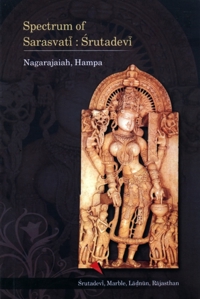The famous Śārada-stotra, 'hymn of Śārada's praise', is so popular in Jaina literary circle that it is sung melodiously and even set to dance performance. Its text is composed in simple and chaste Sanskrit. First I quote the text and render it freely into prose:
Sarsvatyaḥ prasādena
kāvyam kurvantu mānavaḥ
tasmānniścala bhāvena
pūjanīya Sarasvati
śri sarvajna mukhotpannā
bhāratī bahubhāṣiṇī
ajñāna timiraṁ hanti
vidya bahuvikāsinī
Sarasvatī mayā druṣṭvā
divyā kamala locanā
prathamaṁ bharatī nāmā
dvitīyam ca sarasvatī
trtīyaṁ Sāradādevī
caturthaṁ haṁsagāminī
pañcamaṁ viduṣām mātā
ṣaṣṭaṁ Vagīṣvarī tathā
Kumārī saptamaṁ proktā
aṣtamaṁ Brahmacāriṇī
Navamamca Jaganmātā
daśamaṁ Brāhmiṇī tathā
ēkādaśaṁ tu Brahmāṇi
dvādaśaṁ varadā bhavet
vāṇī trayodaśaṁ nāmā
bhaṣā caiva caturdaśaṁ
pañcadaśaṁ Srutadevī
ṣoḍaśāñgaṁ nigavyate
ētani śrutanāmāni
prātarutthāya yaḥ pathet
tasya santuṣyati mātā
Saradā varadā bhavet
[Bappabhaṭṭisūri alias Bhadrakīrti (750-839), Caturvimśatikā, Appendix].
This prayer embodies the quintessence of Jaina conceptualization of Sarasvatī alias Śrutadevī: 'Men compose poetry by the grace of Sarasvatī who worship her with a study mind. She is multilingual because she is born from the mouth of Omniscient i.e., she is the language of Tīrthaṅkaras. She dispels darkness of ignorance and greatly expands learning and looks with divine lotus eyes, rides on the shoulders of goose, her mount, holds vīṇā and manuscript. Her sixteen aliases are Bhāratī, Sarasvatī, Śāradādevi, Haṁsagāminī, Viduṣām-māta, Vāgīśvari, Kumarī, Brahmacāriṇī, Jaganmātā, Brāhminī, Brahmāṇī, Varadā, Vāṇi, Bhāṣā, Śrutadevī and Aṅgam. These are the names of Śruta as well and should be recited in the morning which will please mother Śārada who will bestow boons'.
The palmleaf hasta-prati, manuscript, in Sarasvatī's hand symbolizes her as deity of knowledge, vīṇā as deity of music, akṣamālā as deity of speech, and lotus as deity of purity. In the sequel, we have got to contemplate on her major role as Śrutadevī, most essential to the Jaina pantheon and mythology. The images of Srutadevī grace Jaina temples from ancient times, in addition to Śāsanadevatas, with Jinas being the primary figures.
Śruta, 'that which is heard', is synonymous of the Jaina Āgama, canon or scripture. Sāsanadevatā is different from Śrutadevatā, because Śāsanadevatas are attendant deities who are also called as yakṣis, and Śrutadevī is (Pk. Suyadevī) canon goddess or presiding deity and not attendant deity. She presides over the preachings of Tīrthaṅkaras and Kevalins. Nevertheless, both are protectors of Jaina faith and Jaina canons. Thus they have different roles to play. Further more they belong to different realms. Goddess of knowledge, Sarasvatī, and goddess of wealth Lakshmi, both dwell in Ūrdhvaloka, 'the upper realm', in terms of Jaina cosmology. The sixteen (Mahā) Vidyādevī's belong to tiryagloka, 'the middle realm', whereas the Śāsanadevatas or the yakṣas who are the attendant deities of the 24 Tīrthaṅkaras dwell in adholoka, 'the lower realm'. Similarities and differences in their iconographic features, between Vidyādevis and Śrutadevī / Sarasvatī, may be noted.
Jaina canonical texts like the Dvādaśāṅgas, 'twelve main texts', based on the preachings of Jina, are respected as Śrutadevī's different limbs, and the fourteen pūrvas, 'lost scriptures', as her-ornaments [Nemicandra (1543), Pratiṣṭhātilaka, verses 1-5, pp. 761-62; Paṇḍit Āśādhara (1200-50) Pratisthā-sāroddhāra, chapter 6, verses 27-32].
In other words, Suyadevī is the tutelary goddess of the Jaina scriptures, invoked to dispel the darkness of Jñānāvaraṇīya-karma, 'knowledge-concealing action'. The hasta-prati, 'manuscript', that she holds is in fact śruta, the oral tradition of scripture or the preachings of Jina. The crown on her head has the replica of Jina in the centre. The matijñāna, 'mind-based knowledge', leads to śrutajñāna, 'knowledge derived from instruction and reasoning', which leads to manaḥ-paryaya jñāna, 'direct awareness of thought-forms of others without the aid of mind, and senses', which in turn leads to avadhijñāna or bhava-pratyay jñāna, 'transcendental knowledge'.
The matijñāna is the special knowledge produced from the combination of six sense organs which include 'mind', in addition to the regular five sense organs viz., eye, ear, nose, tongue and skin. The anthropomorphic image of Sarasvatī is the symbol of matijñāna, i.e., pañcendriyas + manas. When she holds manuscript as replica of Śrutajñāna, Sarasvatī becomes more venerable as Śrutadevī or Jinavānimātā. The Gaṇadharas become kevalis, 'those who have attained knowledge isolated from karmic obstruction', and will not be born as women, i.e., they are free from strī-paryāya 'female-mode'. It is in this background that Mahākavi Pampa (941 CE) visualised Sarasvatī, not in the feminine form but as śrutajñāna symbolised, the śruta-book held in her hand (Ādipurāṇa, 1-16).
On the fifth day of the bright half of Jyeṣṭha, corresponding one of the months of April-May-June, the worship of scripture takes place every year since writing of the Ṣaṭkhanda-Āgama, 'scripture in six parts', was completed on that day. This festival or Jaina holiday is named after the Śruta, and is called the Śruta-Pañcamī, 'the scripture fifth', in the Digaṁbara tradition. In the Śvetambara tradition the same festival is called Jñāna (guru) Pañcamī which falls on the fifth of Kārtika-Paurṇami which occurs in the months of October-November. To mark the occasion, ancient palmleaf manuscripts are displayed at places of worship. [Hampana: 2000: 97].
Following verses from three different texts vividly describe the deity:
1.
Śrutadevataṁ śuklavarṇāṁ haṁsavāhanāṁ
caturbhujām kamalānvita dakṣiṇakarām
pustakākṣamālānvita vāmakarāṁ ceti
[Pādaliptasūri III (900-50), Nirvāṇakalikā].
2.
tvamasi ca jinavāṇī sveṣṭa-muktyañga mukhyā
tadiha tava padābjaṁ bhūri bhaktyāṁ namāmah.
iti śrutadevī stavanaṁ paṭhitvā
pratimopari puspāñjaliṁ kṣipet.
[Nemicandra (1543), Pratiṣṭhatilakam, parva. 17]
3.
Srutadevatā śvetavarnā śvetavastradhāriṇi
haṁsavāhanā śvetasimhāsanāsīna
bhāmaṇḍalālaṅkrtā caturbhujā
śvetābja vīṇālankrta vāmakarā pustaka
muktākṣamālālaṁkrta daksiṇakarā
[Vardhamānasūri (1415), Acāradinakara]
 Prof. Dr. Nagarajaiah Hampana
Prof. Dr. Nagarajaiah Hampana
